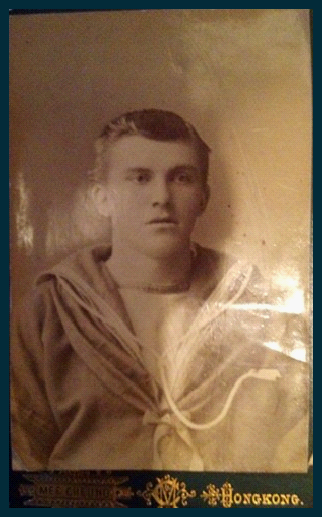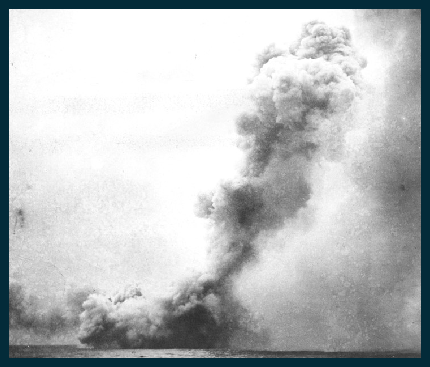Copyright © All rights reserved.



William Lapish

Two such successes were beyond anything the Germans had reason to expect. Admiral Scheer's plan had broken down, and yet they were gaining even more than he could have hoped for...... The casualties were 57 officers and 1,209 men killed; 2 officers and 5 men wounded. One officer and one man were subsequently rescued by German destroyers."
Her wreck was discovered in 1991 and rests in pieces, some of which are upside down, on the floor of the North Sea. Queen Mary is designated as a protected place under the Protection of Military Remains Act 1986 as it is the grave of 1,266 officers and men.
It is probable that is the sailor shown on the East window in St Leonard’s Church is an idealised version of William Lapish. The sailor has two good conduct stripes on his sleeve which is consistent with his documentation. In the background are two naval vessels – one a ship of the line from the early nineteenth century (presumably HMS Impregnable, the Navy training ship on which he started his naval career), and the other an oncoming battleship closely resembling HMS Queen Mary on which he ended it.
William Robson Watson was born on 26th May 1873 in Old Malton and baptised there on 20th September 1874. His mother was Mary Anne Watson, an unmarried servant living at Butcher Corner at the time of the 1871 census. Mary Anne married Charles Lapish in the Malton area in the second quarter of 1877,and by the time of the 1881 census they were resident in Wheelgate and had two children of their own as well as William.
1881 census – resident in Wheelgate, Malton
LAPISH, Charles, Head, Married, M, 48, Butcher, Malton Yorkshire,
LAPISH, Mary A, Wife, Married, F, 36, , Old Malton Yorkshire,
WATSON, William, Stepson, Single, M, 8, Scholar, Old Malton Yorkshire,
LAPISH, Mary E, Daughter, Single, F, 3, , Malton Yorkshire,
LAPISH, Charles J, Son, Single, M, 1, , Malton Yorkshire,
EAM, George, Lodger, Single, M, 22, Tailor, Pickering Yorkshire,
ESKRITT, Thomas, Lodger, Single, M, 30, Groom (Nd), Burlington Yorkshire,
William eventually took his mother’s married surname. According to the Admiralty records he joined the Navy in 1889, having previously worked as a labourer in an iron foundry. At this time he is recorded as being just under 5’5” tall with brown hair, hazel eyes and a fresh complexion. It seems likely that he was one of those whose eye colour changes with mood as other medicals report his eye colour as blue or brown!
He joined HMS Impregnable, the Nay’s school ship, as a “Boy 2nd Class” and transferred to HMS Lion, a training ship in Devonport, a week later. On 12th June 1890 he was promoted to “Boy 1st Class” and in February the following year transferred to HMS Imperieuse. He was soon rated as an Ordinary Seaman and by July 1892 was rated as Able Seaman. HMS Imperieuse was an armoured cruiser, built at Portsmouth and launched on 18 December 1883. She was the flagship of the China Station from 1889 to 1894 and it was presumably during this time that the photograph of William was taken in Hong Kong. On Imperieuse’s return to Portsmouth in early June 1894 William appears to have celebrated all too well and spends five days in the cells before being transferred to the Portsmouth naval barracks. However his conduct was still good enough to warrant the issue of a second class good conduct badge in August though regrettably that was also celebrated too well and he ended up with another 10 days in clink! He remained at the shore establishment in Portsmouth until April 1895, when he was transferred to HMS Australia, the armoured cruiser employed as coastguard ship for Southampton Water, for a year, where he earned another good conduct badge, followed by another 18 months ashore. This was followed by a posting in September 1896 to HMS Melpomene a second class cruiser on the East Indies Station. On the 30th March he was promoted to Petty Officer 2nd Class. In 1900 he rejoined the Portsmouth establishment for about a year, serving some of his time on HMS Duke of Wellington, the flagship of the Navy which was stationed there. In April 1901 he joined the battleship HMS Camperdown , at that time commissioned as a coast guard ship at Lough Swilly and served on her until her return to Portsmouth in May 1903.
Between his discharge from HMS Camperdown and his arrival on HMS Leviathan on 16th June, William married Jane Elizabeth Legget in Portsmouth and in the first quarter of 1904 Elizabeth gave birth to their son William Charles. He served in HMS Leviathan on the China Station until April 1905 when he rejoined the Portsmouth establishment until May 1906 when he joined HMS Royal Arthur, a Reserve ship of the Home Fleet for about a year. A daughter, Lilian Dorothy, was born in late 1906 but died in infancy.William remained in the Home Fleet, serving on HMS Argonaut, before being sent to the North America and West Indies Station with the training ship HMS Euryalus in September 1907. In December 1909 he returned to Portsmouth and another daughter Hilda was born in 1910. In February 1911 he joined HMS Defence and escorted the ocean liner RMS Medina in 1911–1912 while the latter ship served as the royal yacht for the newly crowned King George V's trip to India to attend the Delhi Durbar, returning to Plymouth in early 1912.

After a time ashore he joined HMS Black Prince of the reserve Third Fleet in May 1912, where he was promoted to Chief Petty Officer , 2nd Class in March 1913 and continued to serve on her until April 1914. His wife, Elizabeth had died in late 1913 and the remaining two children seem to have been taken in by his family in Malton, as they both married in the area and some descendants still live near Malton.
He spent another year ashore before joining HMS Queen Mary on 19th May 1915.
HMS Queen Mary was completed in 1913 and participated in the Battle of Heligoland Bight as part of the Grand Fleet in 1914. Like most of the modern British battlecruisers, she never left the North Sea during the war. As part of the 1st Battlecruiser Squadron, she attempted to intercept a German force that bombarded the North Sea coast of England in December 1914, but was unsuccessful. She was refitting in early 1915, when William joined her, and missed the Battle of Dogger Bank in January.
However she was back in service in time to participate in the largest fleet action of the war, the Battle of Jutland in mid-
An extract from the official history reads:
At 4.10, being then eleven miles away abaft the beam of the Lion, he (Admiral Hipper) inclined inwards a couple of points, and as Admiral Beatty simultaneously altered still more to port to press his van, he was able at 4.17 to re-

